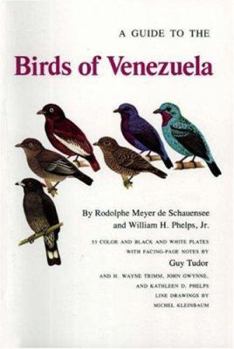A Guide to the Birds of Venezuela
Select Format
Select Condition 
Book Overview
More than forty percent of the bird species known to inhabit South America have been found in Venezuela. Here in one volume is the essential information on this rich and varied avifauna--nearly 1,300... This description may be from another edition of this product.
Format:Paperback
Language:English
ISBN:0691082057
ISBN13:9780691082059
Release Date:May 1978
Publisher:Princeton University Press
Length:528 Pages
Weight:1.65 lbs.
Dimensions:1.2" x 6.1" x 9.0"
Related Subjects
Birdwatching Education & Reference Nature Nature & Ecology Ornithology South America Venezuela ZoologyCustomer Reviews
5 ratings
Fascinating
Published by Thriftbooks.com User , 15 years ago
This is a beautiful book. A wealth of information and easy to use. The illustrations are very true to life. My best buy!!!
Birds of Venezuela
Published by Thriftbooks.com User , 16 years ago
The order was delivered very fast, within 2 1/2 weeks after ordering the book arrived in the Netherlands! Packaging was very good. The book arrived in excellent condition. This seller is in my eyes a guarantee for fast and correct delivery. For this order he's earned five stars.
Hilty's book is not a second edition
Published by Thriftbooks.com User , 21 years ago
There are a couple of risks of misunderstanding with regard to this book that must be made clear here. Firstly it is in no way a second edition. The only things in common with the first guide to the birds of Venezuela, by Meyer de Schauensee and Phelps Jr are the familiar old plates by Guy Tudor, the title, and the publisher. In all other respects it is completely new. Secondly, the "Grand-daddy" review here, clearly refers to the original book and not this one.Having said that, there is little one can add to Chris Sharpe's comprehensive review except to say that I have already used Hilty's book extensively for research this year, along with the other current guides for other countries, and have found it to be the best. In my opinion it sets a new standard. The only small weakness worth noting here is the plates, but has there been a guide that is perfect in this respect?For anybody birding in Venezuela, the book is an essential item to have along.
One of the best Neotropical bird guides available
Published by Thriftbooks.com User , 21 years ago
I believe the earlier reviewers are mistakenly referring to the 1978 First Edition of this field guide (Meyer de Schauensee and Phelps 1978). As the first modern field guide to a South American avifauna, the original Birds of Venezuela is certainly now showing its age though it is still a remarkably useful field aid to the world's sixth largest national avifauna. The new edition - practically an entirely new field guide - is a very different kettle of fish. What makes this new edition different?First of all, the new guide is twice as thick and the text is much more closely packed. The book now weighs in at over 1.8 kg (4 lbs) and is more along the lines of the field guide volume of the Birds of Ecuador (Ridgely and Greenfield 2001). Nearly a hundred new species are treated, taking the country total to 1381. Far more species are illustrated and more colour plates have been used, though eight black and white plates have been retained to depict flying raptors and swifts. We now have 67 plates compared with the previous 53 - a 25% increase. Twenty-five of the plates are entirely new with beautiful artwork primarily by John Gwynne. The new plates cover a range of taxa, with Cracids, owls, nightjars, toucans, tanagers, Fringillids, Emberizids and Icterids particularly well covered. A further four have been adapted from Birds of Panamá (Ridgely and Gwynne 1989) and one from Birds of Colombia (Hilty and Brown 1986). The remaining 37 are basically the same Guy Tudor plates (and one by John Gwynne) from the old edition with some modifications.To my mind, though, it is the text which has really benefited from this new edition - so much so that this should really be thought of as an entirely new field guide. The format follows and improves on the standard set by Birds of Mexico (Howell and Webb 1995) and Birds of Ecuador. The type-setting and text layout have allowed far more text to be included than, say, Birds of Ecuador and Hilty has also been precise and economical with his words. This comes as no surprise to those familiar with Hilty's earlier Birds of Colombia.The text is far more oriented towards identification than in the old edition - the main requisite for a field guide. The first section contains information specifically on identification and this is followed by a section on similar species, where further comparative text is merited. The voice section is new and seems to be very well compiled with - to my taste - excellent transliterations of songs and calls. Much natural history information and further aids to identification are included under a paragraph on behaviour. A detailed appraisal of status and habitat preference is included before the final discussion of range. The text retains the custom established by the earlier edition of separating range information by subspecies, a feature which is particularly welcome in these times of ever changing taxonomy. Range maps are another new feature and they make use of points corresponding to specimen
The Granddaddy of Excellent Neotropical brid guides
Published by Thriftbooks.com User , 24 years ago
This is the granddaddy of excellent neotropical guides. This was first good guide and the one that almost all other quality neotropical guides have copied (including Birds of Colombia and Costa Rica). As such, it is not up to the standard of those later books, but it is still excellent. Very worth having in your library and in the field. Just watch out, the plates in the middle fall out in humid climates (like most of Venezuela!). I had my guide rebound and it now is just fine.




